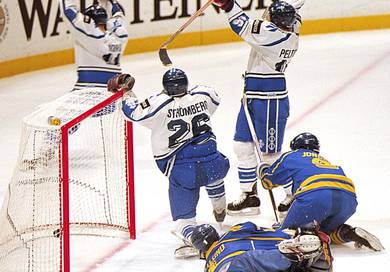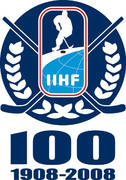Story #26
May 7, 1995 — Stockholm, Sweden
Finally, Finland wins the IIHF World Championship for the first – and so far – only time. And the victory couldn’t have been sweeter. They won the gold medal game against their fiercest rival Sweden, in Sweden and with a Swedish head coach. To really rub it in, the Finnish team celebrated the win in downtown Stockholm, this while also “stealing” the Swedish tune designated for a home-team victory.
As satisfying as the 1995 victory was, it was really overdue. Finland became a hockey power in the early 70s and the first real indication that something was happening was a 3-1-win over Sweden in the 1970 World Championship in Stockholm. But the following two decades of international competition followed the same pattern regarding the outcome: Frequent wins against Sweden, occasional against Czechoslovakia, not a chance against the Soviet Union and all too many disappointing losses against teams like West Germany or weak USA entries. The consistency simply wasn’t there and Finland was never really close to a medal. Things started to change in the late 80s. The Finns finally got on the podium at the 1988 Olympics in Calgary, winning silver after a historic win against the Soviet Union, 2-1. (See: Top Story #95). This success slowly got the Finns rolling as their hockey program also started to develop creative forwards, adding to earlier mix of good goalies and steady defencemen.
After disappointing World tournaments in 1989, 1990 and 1991, the Canada Cup in the autumn of 1991 became a strong indication that the Finns were becoming serious. They tied Canada’s best 2-2 in Toronto, and defeated both Sweden and Czechoslovakia before bowing out against a very strong U.S. team in the semi-final. The next season, Finland finally won their first World Championship medal (silver) after losing the gold medal game to Sweden in Prague. 1994 brought Olympic bronze in Lillehammer and again silver at the World Championship in Italy, where Finland was just minutes from winning the final against Canada. They lost again, this time in a heart braking shootout.
But Swedish coach Curt Lindstrom was slowly and patiently putting the puzzle pieces together and his success formula was spelled “Tupu, Hupu and Lupu” (Finnish for Donald Duck’s nephew triplets Huey, Dewey and Louie). Behind those names was the “Youth-line” of Saku Koivu (born ’74), Ville Peltonen and Jere Lehtinen (both ’73). Lehtinen made his major international debut as a 19-year-old in the 1992 Worlds, Koivu came in one year later, while Peltonen had to bide his time until the 1994 Olympics. There, in Lillehammer they were united for the first time and going to Stockholm in 1995 they were already famous as the “Donald Duck Line”.
Finland now had a perfect mix of experience and joyful youth and no other team had better quality or depth at the key, centre, position. Coach Lindstrom’s four lines were led by Koivu, Raimo Helminen, Esa Keskinen and Mika Nieminen, with excellent middle man Janne Ojanen standing by.
After an early 3-0-loss to Czech Republic, the Finns never looked back. A symbolically important win was a 6-3-trouncing of Sweden in the group stage, an early indication of things to come. Finland waltzed to the quarters where they easily got rid of France (5-0) and they avenged the early tournament loss to the Czechs by defeating them 3-0 in the semi-final. As most experts expected, it was Finland vs. Sweden in the gold medal game. The Swedes had the hopes, the Finns had the players.
The final game was a no contest from the beginning till the end. “Hupu” (Ville Peltonen) scored the three first goals and assisted on the fourth giving “Suomi” an insurmountable 3-0-lead after two with the 4-0-killer coming early in the third.
But the goal that deflated both the Swedish team as well as the partisan crowd was the 3-0-marker, a beautiful tic-tac-toe play between Koivu, defenceman Mika Stromberg and Peltonen who connected with four seconds remaining of the middle stanza. Final score: Finland 4, Sweden 1.
Tupu, Hupu and Lupu were all named to the Tournament All Star Team, while Tupu (Saku Koivu) was named Best Forward of the tournament. Following the emphatic victory and the historic gold medal, the Swedish coach took his Finnish team to Sergels Torg, the square in the heart of Stockholm that usually is reserved for public celebrations of Swedish sports successes. Many Swedes took exception to this “hostile” takeover as 15,000 Finnish residents in Sweden celebrated their heroes on enemy territory. They were singing “Den glider in…” the official Swedish jingle of the 1995 World Championship.
Given all that, the Finns couldn’t have asked for more.
As part of the IIHF's 100th anniversary celebrations, www.IIHF.com is featuring the 100 top international hockey stories from the past century (1908-2008). Starting now and continuing through the 2008 IIHF World Championships in Canada, we will bring you approximately three stories a week counting down from Number 100 to Number 11.
The Final Top 10 Countdown will be one of the highlights of the IIHF's Centennial Gala Evening in Quebec City on May 17, the day prior to the Gold Medal Game of the 2008 World Championship.
These are the criteria for inclusion on this list: First, the story has to have had a considerable influence on international hockey. Second, it has to have had either a major immediate impact or a long-lasting significance on the game. Third, although it doesn't necessarily have to be about top players, the story does have to pertain to the highest level of play, notably Olympics, World Championships, and the like. The story can be about a single moment — a goal, a great save, a referee's call — or about an historic event of longer duration — a game, series, tournament, or rule change.
|
 |
Click here for the 100 Top Stories
|











